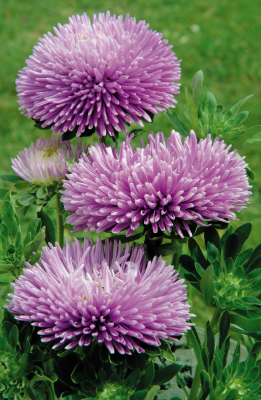

Gala Lavender
Item no.: CC0206R- Large double flowers up to 3.5-4” (8-10 cm)
- Pincushion petals
- Strong, sturdy and long stems
- Clear, intense colors
- Also suitable as bed or container plant
- Crop Time
- Spring: 14 - 15 weeks
- Height ∅
- 31 ″ / 80 cm
- Exposure
- Sun - Partial shade
- Seed Form
- Raw Seed
- Best Uses
- Bedding, Cutflower
Culture guide
Usage
Plants for the border, pot and container plants, plants for patio and window boxes, cut flowers
Sow time
January for flowering in May (artificial long days); May for flowering in September (natural day length); July for flowering in January (artificial long days)
Sowing method
3-5 seeds per plug, sowing in final pots is possible
Germination
10-12 days at 68-70 °F (20-21 °C), cover seed lightly with vermiculite after sowing. To prevent premature flowering, keep plants vegetative with a four hour night interruption
Growing on
Transplant plugs after 3-4 weeks. Grow on at 58-60 °F (14-16 °C). Cool temperatures promote a good plant habit, but may delay flowering.
Media
Use a well-drained, growing substrate with 20-30 % clay, 1-1,5 kg/m³ complete balanced fertilizer, 0-2 kg/m³ slow release fertilizer (3-6 months), iron-chelate, micronutrients, pH: 6.0-6.5. Use a sterile medium and sterile pots/containers as preventative measures against Fusarium and Verticillium. Field: sandy loamy soils with good drainage and moderate nutrition levels. Standard fertilization: 80-100 g/m² slow release fertilizer. Disinfect the soils in greenhouse before planting.
Temperature
Grow at 12-15 °C. Callistephus do not grow temperatures below 8 °C and do not tolerate frost. The lower the temperature, the better the plant habit but onset of flowering will be a little delayed. Lower temperatures combined with short days cause the development of a leaf rosette and short stems.
Fertilization
Moderate-high fertilization levels are required. Fertilize the crop weekly with 100-150 ppm nitrogen (at 2 kg/m³ slow release fertilizer in substrate), using a potassium balanced fertilizer (N: K₂O-ratio: 1:1,5). Avoid high ammonium and high nitrogen levels. High nitrogen levels will cause smooth stems. Prevent magnesium deficiency by applying magnesium sulphate (0,025 %) 1-2 times and in case of iron deficiency apply iron-chelate for 1-2 times.
Field: N min soil value: approximately 150 g/m².
Stage I Starts with the radicle breaking through the testa. The roots are touching the medium. Ends with fully developed cotyledons.
Stage II Starts from fully developed cotyledons. Ends with the fully developed true leaf or true leaf pair.
Stage III Starts from the fully developed true leaf or true leaf pair and ends with 80% of the young plants being marketable.
Stage IV All young plants are ready for sale and in the process of being hardened off. This stage lasts about 7 days.
The cultural recommendations are based on results from trials conducted under Central European conditions. Different conditions in other parts of the world may lead to deviations in results achieved.






